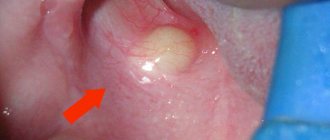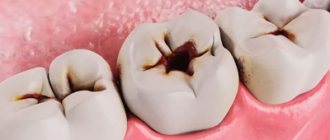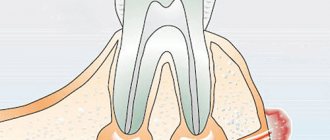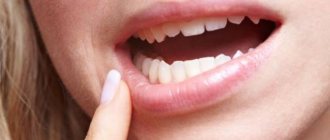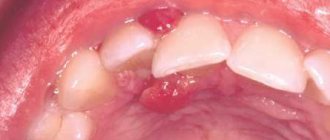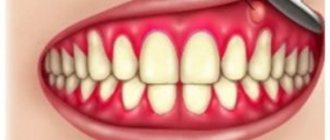In cases where pulsating sensations are accompanied by aching pain in the gums, we can talk about one of the most unpleasant dental problems, since even painkillers are usually powerless.
There is no single answer to the question why the gums are pulsating: it could be the result of the dentist’s careless work (a mistake made when filling a tooth) or a consequence of pathology.
This article is about the possible causes of pulsation in the gums and recommendations regarding actions that are advisable before seeking dental care.
What does pulsation in the gums indicate?
Pulsating sensations in the gum against the background of its swelling and pain are a clear signal of the presence of an inflammatory process in the mucous membrane associated with injury to soft tissues and the penetration of infection into them (the strength and frequency of attacks are important in diagnosis).
In addition, the symptom may be a consequence of various pathological processes. The most frequently diagnosed are:
- progressive caries short-term attacks of pulsating pain are possible with carious destruction of the middle and deep stages, most often provoked by external irritants - such as a reaction to cold/hot, sweet/salty.
- acute pulpitis is a complication of caries associated with the penetration of harmful microorganisms deep into the dental tissues: upon reaching the pulp, they provoke a serious inflammatory process, accompanied by severe painful sensations, which usually intensify at night.
- periodontitis is a consequence of untreated pulpitis (or, alternatively, the result of poor-quality treatment of dental canals), accompanied by the formation of a purulent abscess at the root of the tooth.
Other factors can also provoke pulsating pain in the gum tissues; only a specialist can determine the real cause of the problem, therefore, if you feel pulsation in the gums, do not delay your visit to the dentist!
Symptoms
The inflammatory process manifests itself as follows:
- The gums turn red and become unnaturally soft when touched.
- Uncontrollable bleeding appears.
- The cervical area is exposed, the teeth seem longer than usual.
- Loosening begins.
- Chewing food becomes painful, any touch causes discomfort.
- Bad breath does not go away even after regular brushing.
If, against the background of symptoms, a doctor diagnoses gingivitis, then it comes in three types:
- Catarrhal - redness is accompanied by itching and aching, prolonged pain.
- Ulcerative - resembles aphthous stomatitis, but with a large number of characteristic whitish lesions. It is extremely painful.
- Hypertrophic - gum tissue grows to large sizes under the influence of hormones. In most cases it is treated with surgery.
If the patient has crowns installed, this complicates the diagnosis and further treatment of inflammation. In some situations, dentures must be removed in order for therapy to proceed properly.
The most common reasons for visiting a dentist
As we have already seen, pulsation in the gums can be the result of an injury to the mucous membrane or a consequence of one of the dental diseases. Now let’s take a closer look at the types of painful sensations that patients who are concerned about this symptom most often go to the dentist with.
Pulsation without pain
Pulsating sensations in the gums without significant pain are the most likely symptom of the development of apical periodontitis: the process of releasing space for purulent exudate that accompanies the problem causes the sensation of a distinct pulse within the jaw.
As a rule, there are no unpleasant sensations at rest, but they appear under any stress (during hygiene, when eating food, when applying pressure). The symptom is characteristic of any inflammatory processes in periodontal tissues, as well as in the initial stages of the formation of a hilar cyst.
Discomfort under the crown
The appearance of pulsation under the crown is evidence of unprofessional work by the dentist: the most common cause is infection during root canal cleaning or poor quality treatment of the nerve.
The only way out in such a situation is to urgently consult a doctor: a delay in eliminating the consequences of such a medical error can lead to tooth loss.
Discomfort under the filling
Unlike the previous case, pulsation in the gum under a recently filled tooth does not always indicate a mistake by the dentist. It is important to distinguish the stage of treatment here:
- When installing a temporary filling, pain and pulsating sensations are acceptable during the first few days, since temporary filling is most often carried out with the addition of a devitalizing agent to destroy the neurovascular bundle. The killing of the pulp occurs gradually, but a visit to the doctor is justified if the discomfort persists for more than 2-3 days.
- If discomfort is felt under a permanent filling, it is advisable to get dental care as quickly as possible. The causes of pain can be different; a competent diagnosis based on an X-ray examination of the problem tooth is necessary.
Discomfort in the area of the extracted tooth
Unpleasant sensations, including throbbing pain, after tooth extraction are a natural and inevitable phenomenon, since it takes time to restore damaged tissue.
But after such an operation (especially after the removal of a wisdom tooth), patients should listen very carefully to their feelings so as not to miss the moment of possible complications, such as alveolitis (suppuration of the tooth socket as a result of the loss of a blood clot protecting the wound from infection).
Swelling of the gums due to periodontitis -
In case of poor-quality root canal treatment, due to tooth trauma, or in the absence of timely treatment of caries and pulpitis, inflammation occurs at the apex of the tooth root, which dentists call “periodontitis.” Sometimes the terms “granuloma” or “cyst” are used to refer to periodontitis, which you may well have heard. Such names are due to the fact that the focus of inflammation at the apex of the tooth root in these cases has the appearance of a purulent sac.
Symptoms - usually periodontitis has a chronic asymptomatic course, or there is only slight pain when biting on this tooth. But sometimes periods of exacerbation of inflammation occur, and in this case, acute pain may first occur in the causative tooth (especially when biting on it), and a little later, swelling of the gums usually appears in the projection of the causative tooth. But sometimes pain may be completely absent, and patients complain solely that the gums near the tooth are swollen (Fig. 1-3, 7-9).
Please note that with periodontitis, the source of inflammation is located at the apex of the tooth root, i.e. quite deep in the bone tissue. Therefore, swelling of the gums during periodontitis usually develops not just in the projection of the causative tooth, but most often in the projection of the apex of the root of the causative tooth. And in multi-rooted chewing teeth - no less often in the projection of the bone interradicular septum. But periodontitis is not characterized by swelling of the interdental papilla or the gingival margin adjacent to the neck of the tooth.
In general, if you have swelling on the gum in one of your teeth, pain occurs when you bite on it, and there is a crown, filling or carious destruction on the tooth, and also if, in addition to swelling on your gums, you also have swelling of soft tissues face (again in the projection of the causative tooth) - you can definitely make a diagnosis of “Exacerbation of chronic periodontitis.” An X-ray of this tooth will allow you to accurately determine the cause of periodontitis and the required amount of treatment.
What treatment may be required -
As we said above, if the gums are swollen and painful, then in most cases the reasons are poor-quality filling of the canals, or the lack of timely treatment of dental caries and pulpitis. Only according to official statistics, root canal fillings are performed poorly by dentists in at least 60-70% of cases. The main errors during treatment are underfilling of root canals, poor obturation of root canals with filling substances, breakage of instruments, perforation of the tooth root...
As a result of this treatment, a focus of purulent inflammation appears at the apex of the tooth root. Moreover, in the absence of timely treatment of the tooth for caries and pulpitis, exactly the same focus of inflammation will appear at the apex of the tooth root, but only against the background of unsealed root canals. In Fig. 10-12 you can see how the inflammation at the apex of the tooth root looks like during periodontitis (on the diagram, x-ray and on the root of the extracted tooth) -
Below we describe several treatment options that may be possible for patients with gum swelling due to dental periodontitis. In any case, the doctor will first be forced to take an x-ray. The image will allow us to determine whether this tooth can be saved at all, the size of the inflammatory focus at the apex of the root, and whether root canals have been filled in this tooth previously. The treatment tactics will depend on the latter, and below we will tell you how to cure a tooth and remove swelling from the gums so that it does not appear again.
1) If the channels are not sealed -
If root canal treatment has not previously been carried out on this tooth, then standard treatment of periodontitis is carried out with mechanical treatment of the root canals and treatment of the source of inflammation behind the root apex. On your first visit, they will open your tooth, expand the root canals to allow pus to drain out through them, and leave the tooth open for several days, prescribing antibiotics and anti-inflammatory therapy.
If necessary, your dentist may then refer you to an oral surgeon to make a small incision in the gum to allow additional drainage of pus. After about 3-5 days, the doctor makes an appointment for a second appointment and, if the inflammation subsides, completes the mechanical treatment of the root canals and seals them - either first with a temporary medicinal paste, or immediately with gutta-percha (the latter depends on the size of the source of inflammation at the apex of the tooth root). You can read more about the treatment of periodontitis at the link above.
How the gum incision is made - significant swelling of the gums, or if your gums and cheek are swollen at the same time - indicates the formation of a large purulent abscess, which will require not only opening the root canals of the causative tooth, but also making an incision in the gums to release the pus. The incision is made under local anesthesia, the wound is then washed with antiseptics and a drain is inserted into it (see video below).
2) If the channels are sealed poorly -
If an x-ray shows that canal treatment has already been carried out previously and the cause of inflammation was incomplete filling of the root canals to the apex of the tooth root, then there are 2 treatment options: either standard conservative therapeutic treatment, or an option associated with resection of the root apex.
- Conservative therapeutic treatment - on the first visit, the filling/artificial crown is removed from the tooth, poorly filled root canals are unsealed, washed with antiseptics, and antibiotics are prescribed.
If necessary, the patient is referred to a dental surgeon to make an incision along the gum. Thus, to the treatment we described in the previous section, only 1 point was added here (unsealing the root canals). Then everything is the same - after the inflammation subsides, temporary or permanent filling of the root canals is carried out. If the source of inflammation is small, the canals are usually filled immediately and permanently with gutta-percha, and a permanent filling is placed at the next visit. If the inflammation is large, the canals are sealed with temporary medicinal paste for 1-3 months, and a temporary filling is placed. And only after this time the canals are filled with gutta-percha + a permanent filling or crown is placed. - Resection of the root apex (Fig. 13) –
This surgical method is much simpler and much cheaper than conventional therapeutic treatment, and it allows you to avoid removing the crown from the causative tooth in order to unfill and reseal the root canals.
However, this method is only suitable for those teeth in which the root canal was poorly filled only at the very apex of the root (and throughout the rest of the length the canal should be filled normally). This simple surgical operation is carried out within 25-35 minutes and consists of cutting off the apex of the root with the unfilled part of the root canal using a drill. To do this, an incision is made along the gum and a flap of the mucous membrane is moved back to give access to the bone tissue in the projection of the apex of the tooth root. Next, a small hole is made in the bone with a drill, through which the apex of the root is cut off and removed from the wound along with the granuloma/cyst at the apex. The wound is sutured and antibiotics are prescribed. Pros: cheap, simple, no need to remove the crown and re-treat the tooth.→ How is root resection surgery performed?
ethnoscience
The main recommendation is decoctions of medicinal herbs (chamomile, sage and oak bark): a teaspoon of crushed dry plant in 200 ml of boiling water, infuse, strain and use for rinsing the mouth.
You can also:
- apply cold to the cheek;
- rinse with a soda-saline solution (2 grams of salt and soda per glass of warm water), for acute pain - every quarter of an hour;
- chew propolis (provides slight numbness of soft tissues);
- Apply a cotton wool soaked in eucalyptus or clove oil to the tooth.
Although these recommendations are time-tested, prior consultation with a doctor is advisable.
How to treat gum disease
Treatment of sore gums
Before the dentist prescribes a treatment program, it is necessary to undergo a diagnosis:
- General visual examination of the oral cavity for caries and other related diseases.
- Palpation of gums, periodontal zones, identification of painful reactions.
- Sight X-ray or panoramic tomography of the jaw.
When the diagnosis is made, carious and allergic factors are excluded, the patient is prescribed home treatment, which includes:
- Daily rinsing with antiseptic solutions (chlorhexidine, miramistin and their analogues).
- Antibacterial and analgesic ointments and gel (Cholisal, Kamistad, Metrogil-denta, etc.).
- If necessary, a course of antibiotics and antihistamines to stop the further spread of inflammation.
Surgical intervention is required only for hypertrophic forms of gingivitis, a detected dental cyst or purulent periostitis. In other situations, doctors try to avoid invasive methods so as not to injure the gum tissue even more.
pharmaceutical products
The choice of a pharmaceutical painkiller should be made taking into account the characteristics of the pain syndrome - its intensity and frequency:
- for moderate pain, non-steroidal anti-inflammatory drugs (Aspirin, Paracetamol) are suitable, which can reliably alleviate the condition for a couple of hours; if pain increases in the evening, you can add an antispasmodic (Spazmaton, No-shpa)
- with severe pain and pronounced pulsation in the gums, more powerful drugs will be required - such as Nise, Ketorolac, Nimesulide.
It is important to understand that painkillers do not solve the problem; pain relief is only a respite that does not relieve the need for dental treatment.
After eliminating the acute manifestations of the inflammatory process, it is necessary to consult a doctor as soon as possible.
By postponing a visit to the dentist, saving yourself from pain using folk or pharmacy remedies, you risk bringing the situation to a critical point, when saving the tooth becomes impossible!
Prevention of gum inflammation
You can protect yourself from unpleasant symptoms by following a number of simple rules:
- Brush your teeth not 2 times a day, but after every meal. If this is not possible, make it a rule to rinse your mouth thoroughly with clean, warm water.
- Balance your diet - increase the amount of fiber, fruits and vegetables, dairy products.
- Individually select not only a toothbrush, but also a toothpaste with mouthwash, based on the condition of the oral cavity.
- Treat caries and other problems in a timely manner, without delaying diagnosis.
- Visit the dentist's office twice a year for a preventive examination.
